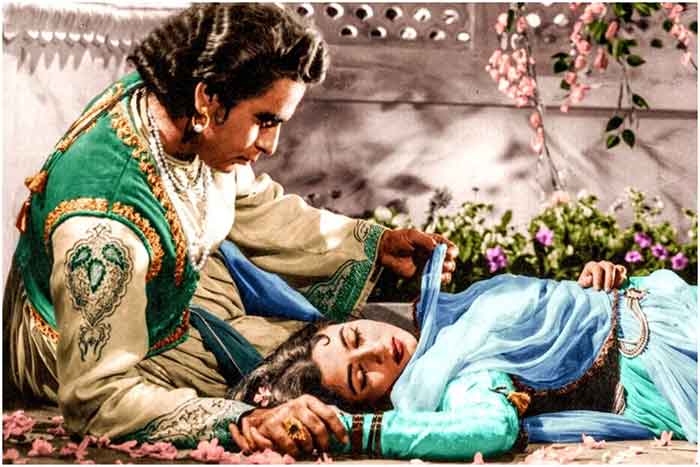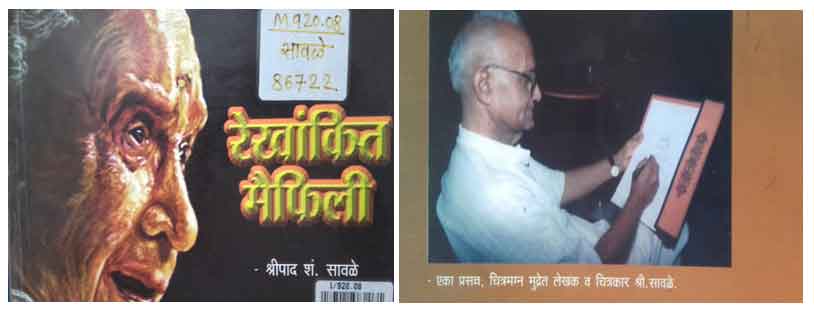It was Tuesday, August 4, 2009 in the Europe Tour. Before that I only knew a little about Monet, Leonardo Da Vinci, Vincent van Gogh, Rembrandt, Pablo Picasso, but I was very happy today because we went to see the world-famous Vincent van Gogh Museum in Amsterdam. We got there in the morning. As usual, there were crowds of tourists from all over the world. It is the largest museum of Van Gogh’s paintings. The museum has more than 200 paintings, Five Hundred Drawings, four sketch books, and seven hundred letters written in Van Gogh’s letters. It is an excellent example of how the artist’s art becomes profound and beautiful. He is one of the leading artists in the post-Impressionist painting movement that has flourished in France since the 1880s. The movement emphasized the representation of human mental, emotional, symbolic, intellectual and spiritual elements in painting.(1)
In addition to Van Gogh’s paintings, the museum also has beautiful works by contemporary French artists, Monet, Paul Gauguin, Odilon Redon, and Georges Seurat, Emphasis is placed on French art from 1840-1920. The hundred best paintings in this museum are known as ‘Master Pieces’. Of these, 75 are by Van Gogh and the rest are by other painters. The journey of a great painter like Van Gogh in just 10 years is astounding.

Establishment of the Van Gogh Museum
It will be interesting to see a brief history of how the Van Gogh Museum was established and erected. Van Gogh had a younger brother named Theo. ‘Theo became the Respite and the Pillar of Van Gogh’s hard and arduous life. Van Gogh used to send all his paintings to Theo in Paris. Theo valued his brother very much. Throughout his life, he provided moral as well as financial support to Van Gogh. He used to send a certain amount of his income to Vincent. Van Gogh died in 1890 at the tender age of 37. Theo died in 1891. After Theo’s death, the collection of all the paintings went to Theo’s son, William Van Gogh, by law. Theo’s wife, Johanna, was working as a manager. She started promoting Vincent’s work, selling paintings in various exhibitions. But she founded ‘Vincent Van Gogh’ Institute with the hope that the wealth of his Art would be open to all, not just confined to the family. The museum opened on June 2, 1973. But with the ever-increasing number of tourists, a new ‘Oval-Circular’ pavilion was conceived in 1999 by the well-known Japanese Architect Kurokawa Kisho..
The new building has four floors and the first floor contains only the famous illustrious works of Van Gogh. On the second floor, there are modern facilities like Study Room, computer, books, educational exhibitions, printing room. On the third and fourth floors are paintings by Van Gogh and other contemporary artists, as well as Van Gogh’ letters preserved by Johanna. With great foresight, Johanna has saved it all. The whole art world, as well as art lovers, must be thankful for her foresight, otherwise we would never have known a great- glorious Aartist like Van Gogh.
Such a well-known painter was born on March 30, 1853, in the small village of Zundert in Netherlands. It is said that a child’s feet in the cradle appear to provide inklings of what the child is destined to follow, but in his case the picture is slightly different. On the same day a year before his birth, his mother had given birth to a ‘stillborn baby’. Hence his mother also named him ‘Vincent’ as shadow of the dead son. However the estrangement, shadow of this mother’s ATTACHMENT TO adored Dead Vincent haunted the new bon Vincent throughout his life. Mother’s ignorance of him and her idealized Image of Dead Elder Vincent, created deep wedge into Vincent’s psyche. He could never find the true love of his mother even when he was alive. As a child, he lived a lonely, neglected life, wandering alone in the fields. He did not have even iota of an idea about his skills of the art of painting. The separation from his mother at such a young age had a serious effect on his mental balance and as he got older, it was transformed into a very deep mental disorders. He worked obsessively to replace his mother’s love and find Self Identity!
Born into a prestigious ‘Dutch’ family, he began working as a trainee at an art firm in partnership with his uncle at the age of sixteen. From then until the age of 27, he worked as an art dealer, school master, and missionary worker, but he did not last long. He moved from career to careen, job to job, country to country, city to country, country to city and to other country sides. In 1878, he went to the Borinage, a mining district in Belgium, and worked among the poor as a lay preacher. But his close associations with coal miners made him to pay the price in less than year’ the religious organization sponsoring van Gogh dismissed him. He returned to his hometown in 1879. But this experience had a far-reaching effect on his later life. He continued to feel deep compassion and love for the lives of farmers and workers. This love became the ‘energy’ that could transform the repressed instincts into painting. Coal miners called him “The Christ of the Coal Miners”.
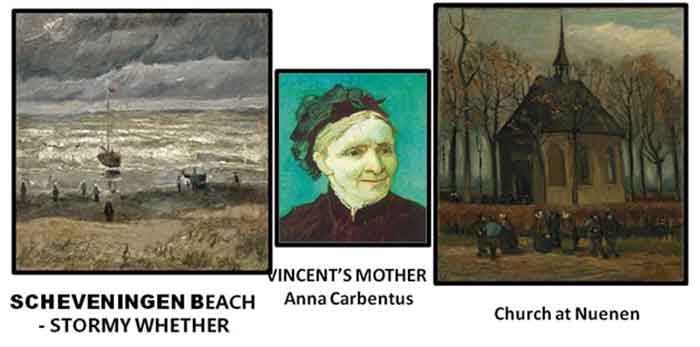
At the suggestion of his younger brother, Theo, he decided to pursue a career in painting. In December 1881, under the tutelage of a realist painter, Anton Move, who was married to his cousin (Mevhana), he began to draw the first series of paintings. Anton’s name is mentioned several times in Van Gogh’s letter writing.
In 1884, his mother had an accident in which Van Gogh’s mother’s thigh bone was broken. With his sister ‘Will’, he served his mother wholeheartedly. At the time, he gifted his mother with a picture of the newly renovated Nuenen Church in the village.
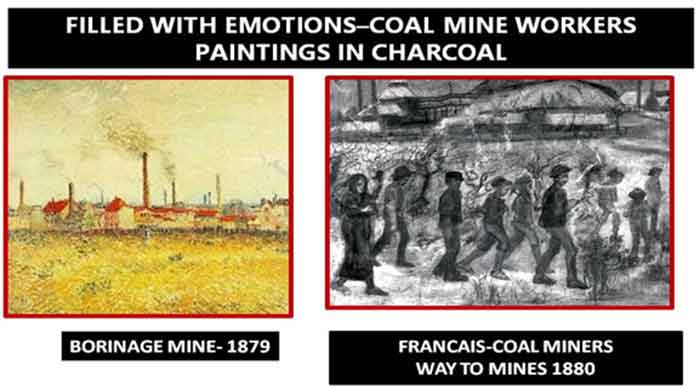
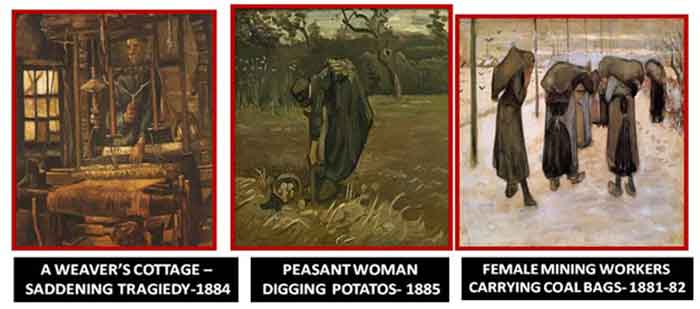
From an early age, he was influenced by the peasants, workers, and weavers around him. His intimate, closely knit ‘Emotional relationship’ with the working life is felt in every one of his paintings. Industrialization, its workers and its profound impact on rural life were the topics well rooted in his mind. For the miners, he worked devotedly, poured out all his energies for them, even took off his shirt in the cold and gave it to worker. Industrialization and its devastating Impact on life of workers and its profound impact on rural life were the topics deeply rooted in his mind. The expression of his brotherhood and painting of their struggle full life are well reflected in his paintings. And that is why his paintings are perfected with vivid colors, associations and sensations. He has painted many pictures of miners with charcoal..
In April 1885, he painted “The Potato Eaters”. Prior to that he did basic sketches, portrait studies and lithographs. ‘Potato Eaters’ is considered to be one of the finest examples of his art, he is known as a ‘masterpiece’. It is simply impossible to separate and get a farmer away from his land! The “Group Family”, exhausted, sweating from working in the fields, used to come to Van Gogh as a model.
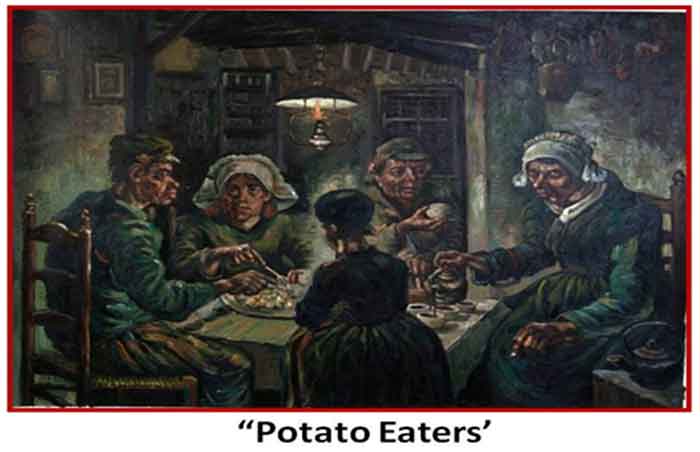
These farmers had a lot of respect for him. They used to peel the potatoes they had produced and peel them from the trays with the same hands that they used to plough in the fields. This is their kind of subsistence! So he has used the color of these “peeled” potatoes for this picture. Initially he used to get closer to them to draw the Paintings. However taking into consideration the advice from Co-Artist he began drawing pictures well grounded into his mind. This time, he painted the picture with the cloth on the table, the smoky walls, the lamp hanging on the rugged beams, the hands of the men and women eating the potatoes, and the expressions on their faces. To paint their rough Faces resulting from Excessive physical exertion, he deliberately used dark earthen-soiled color. He wanted to portray ‘them’ as they were. Portraying the Joy, sorrow and pain in the life of he wanted to portray the ‘Rhythm of their Universe”. His goal is to keep working until he paints and articulates the picture exactly that is theire in his Imagination. He had that much of perseverance for achieving it and that’s why he used to work like an hysteric or Fanatic.

Van Gogh’s true identity comes to us more from his paintings. His work was limited to a period of 27 to 37 years of his life. During these ten years, he drew as many as 900 paintings. If nine hundred pictures are to be fitted over a period of ten years, he draws a new picture every thirty-six hours.
The mother, upset by the loss of her first child, never fell in love with Vincent. The emotional distance between mother and child reached a climax. This had a profound and lasting effect on his mind. His temper had become eccentric. The ‘incompatible’ relationship with his parents, the constant scarcity of money, the unstable and tough life, and the uncertainty made him very excited at times and sometimes very depressed. He was found in this maze.
On one such occasion, he had a heated argument with the painter Paul Gauguin. On that occasion he did not raise his hand against Paul Gauguin or make any blows. He cut off his left ear in a fit of rage! In the midst of this mental shock, he gave her a severed ear as a gift to a prostitute.
Still life and Unusual pictures
His journey in painting was limited to only 10 years. During these ten years, he painted in various places, locations, such as Nuenen, Antwerp, Paris, Arles, Saint Remy, Auvers . During this time he had made his mark in all fields like skate Boards, Nature paintings, Portraits, Still pictures, Lithography. But most importantly, he has given Central Place to the common working man.
Still Life with Bible is one of my favorite still picture. In October 1885, Van Gogh drew a picture of the open Bible on a table that was striking, captivating, and a symbol of clarity. This was his father’s Bible. And next to it is the book ‘La Joie de Vivre’ (Happiness in Life) by French author Emil Zola. He thought it was a modern Bible. In other words, he has shown different views of ‘father and son’ in this picture.

His other picture with him is “A Pair of Shoes”. It is a very realistic picture, and a symbol of expression. Van Gogh saw deep meaning in these torn old shoes. It depicts the most traumatic and difficult path that Van Gogh has taken in his life. Simultaneously, the ‘worn-out shoes’ of hard-working ordinary laborers, their toil and Shoes seem to represent a metaphor for their lives. We get a precise vision of the ordinary workers’ difficult life and their protracted struggle.
Breakthrough in Vincent Vangogh’s life as painter took shape during 1981 to 1985. His working life enabled him to develop organic attachment and sympathy for Peasants and working class people. He painted their efforts and sorrows to gain control over the Nature.
The paintings are illustration Vincent’s attempt towards sublimation of his own repressed emotional life caused by deep wounds inflicted into his psyche by negligence of his childhood desires by his Parents. The articulation of Paintings depicting his empathy for the wretched life of laboring population enabled him to overcome and put up fight against his own bouts of depression and self loathing. He vociferously painted the life of peasants sowing seed, ploughing the fields and harvesting the life of underground miners and ordinary laboring population facing the brunt of Netherland’s Industrialization.
Van Gogh’s ‘Self Portraits’
He did not have enough money to support himself, so paying money to Models was out of question, hence he started taking self-portraits. Today, they are world famous. Most of the pictures are of right faced, because he had his left ear cut off and covered with a scarf for many months. At times he used to draw a second picture on the first picture as he did not have money many times to draw a new picture on canvas. During his stay in Netherland in 1881- 83, he had painted series of portraits of his mistress, Sien Hoornik, whom he had chosen as one of her models. However he failed to have family life with her.

He has painted more than 35 ‘self-portraits’. He actually painted 25 portraits of himself in Paris between 1886 and 1888. Many of the paintings show him wearing a ‘straw hat’, while others show the painter in his loose tunic or suit. As he drew, his Self Portraits, he was always keen to provide fullest expressions to his psychic – emotional world on his face.

He was obsessed with getting to know his own state of mind and the universe through portraits, a kind of ‘Self Analysis’. Pink gray face, green eyes and gray hair, wrinkles on face and forehead and red beard! It depicts a sad man who has been generous to the soul. The shadow of death seemed to be hovering on his face. This is the last ‘self-portrait’ taken before committing suicide in 1890. His record of working out self portraits is Parallel to that of Seventeenth Century Dutch Painter Rembrandt Harmenszoon.

Starry Night is an oil-on-canvas painting by Vincent van Gogh, a post-Impressionist painter, painted in June 1889, just before sunrise. This view is depicted from the scene from East facing window of the (Asylum’s shelter room, in Saint-Remy-de-Provence), in which an imaginary village is situated.
The “mental breakdown” of December 23, 1888 (when he “self-amputated” his left ear), followed by Van Gogh’s voluntary admission in to St. Paul’s Asylum on May 8, 1889. ‘ Starred Night’ is a very famous and acclaimed oil painting. The brightest “star” seen in the picture is the shining “Venus-star” to the right of the “Cypress” tree. This “Cypress” tree is known as the symbol of death. Psychoanalysts have identified his death by suicide he committed on July 29, 1890 as symbolized in this Painting. Psychoanalyst say that the artist’s restless, ‘dreamy state of mind’ has been expressed by Van Gogh in this painting. Some analysts have identified the confrontation between Venus and the rising Cypress as a visual representation of Van Gogh’s psychic – Mental struggle to get out of his turbulent state of mind.
Van Gogh’s ‘Sunflowers’ paintings are known as the world famous and most expensive artifacts. Out of all the flowers, he had deliberately chosen sun flowers. He wanted to explore different shades. He drew the first sunflower while in Paris.He wanted to explore different shades..Paul Gauguin was very impressed when he saw the picture. So in the artist’s colony in the Yellow House, Paul Gauguin was greeted in the bedroom by a series of Van Gogh sunflower flowers before he arrived, and some of the paintings were deliberately hung on the wall. They used sunflowers to express gratitude.
Van Gogh’s letter writing
Letters written by Van Gogh are the window to his ‘universe’. Vincent van Gogh was a very passionate letter writer. One third of his letters are written in French. The letters are special because of the ‘line drawings’ drawn on them. His letters reflect his world-class literary style. His letters have provided historians the material leading to Analysis of his paintings and biographical data. More than six hundred letters have been written to his brother, Theo, some to his sister Will and relatives, and the rest to artists like Emily Bernard. ‘Theo’ fell in love with Van Gogh. Van Gogh felt the need to share his thoughts and feelings, and he filled in the blanks. He used to express all his feelings to him in letter. The letter became a mirror of Van Gogh’s latent mind and life. ‘Letters and pictures’ were very important in his life. These letters are very important as a chronology of an artist’s life. The Amsterdam Museum has the largest collection of his letters. These letters are considered to be the most important document that sheds light on the events of his life.

Van Gogh writes in a character he wrote to Theo when he found himself in a ditch of apathy and depression, “I’m very angry with myself, because I can’t do what I want to do, and at the moment I feel like I’m lying on the bottom of a deep dark well with my arms and legs tied and I’m completely helpless.” These words provide us insights into his ‘Unconscious’ and his strivings to articulate his ‘inner self’ against the insurmountable repression he was subjected to.
The articulation and invention of this struggle is found in Van Gogh’s utterances. We come across various utterances or ‘Quotes’ in his letter writings which provide us insights into the Psychical Processes which spring from painful essence, from the depth of his Unconscious and appear on the surface of his consciousness. Following Quotes are remarkable.
1 “These paintings come in my dreams and I paint these dreams in these paintings”.
2 “I always think that night is more alive and more colorful than day”.
3 “There is peace even in storms”
4 “When I fall I rise again”
5 “Art Is Long and Life Is Short”
His utterance to Thio before his death speaks volumes, “Only sorrow is eternal”.
In the end, while fighting a life-threatening struggle with mental illness, Van Gogh wrote consistently and repeatedly about the Sublime Joy and immense perfection he had achieved in art – it was with such intent and creativity that he was able to “undoubtedly” overcome the backdrops in his miserable and painful short life of Thirty Seven Years.
Drawing of picturesque landscapes
He painted many landscapes from 1882 to 1890, but the main period of his Landscape painting was from 1885 to 1888. Today they are preserved and grouped into five volumes. The pictures are as beautiful, captivating appear to have been clicked and captured by a great camera. They are bathed in the beauty of nature covering landscapes of mountains, valleys, fruits, flowers, leaves, wheat fields, farm houses, forests, beaches, and so on. But a closer look at them by the critics reveal Van Gogh’s humane point of view and strikes a chord in our heart.
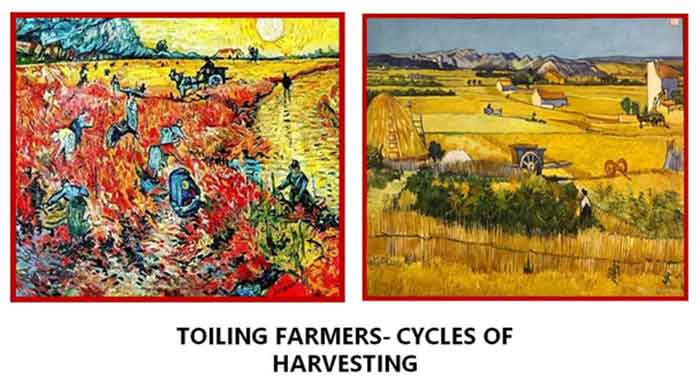
(CYCLES OF LIFE WITH HARVESTING)
He was, in fact, living in a madhouse, and he was inspired to draw pictures of nature and the gardens created by the by human labor inspired him to draw pictures of nature, scattered around this asylum.
Van Gogh was the first to see the true and true nature of the lives of the peasants, workers, agricultural laborers who worked on them, so they are pictures of the lives of the workers. From this ‘Asylum’, there are 12 pictures of nature seen through the window.
He could see the sun rising in the fields of ripe wheat. As the sun moves forward in the sky, the changing colors of the landscape make him feel like the changing colors of life! As a metaphor for life, the life cycle of wheat and agriculture – the crop grows, it grows, harvested, and it sustains human life. Van Gogh has painted all these stages, including 10 paintings and 5 drawings in a week-long series called ‘Cycles of Life with Harvesting’.
Storey of Sun Flowers Nature Paintings and that of ‘Yellow House’ in Arles
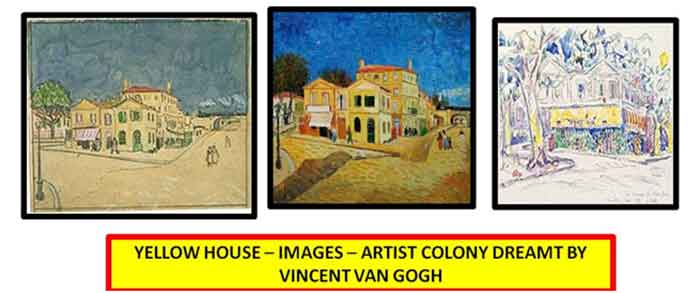
Van Gogh had a dream. There should be a colony of ‘like-minded’ painters, co-artists, the Artists in France, where all the painters would live under one roof and have one studio. For this, he rented four rooms in a mansion on May 1, 1888 and renamed it YELLOW HOUSE. In Japanese culture, yellow is considered a symbol of friendship. So he also painted the walls yellow from the outside. It was not expensive but it was a colorful studio with yellow colorful chairs and tables.
Among Van Gogh’s paintings, the ‘Sunflower Artwork’ is one of the most famous and most expensive works of art in the world. Its Sun-Dark, Bright colors, the various shades of the same yellow color, Exciting and enticing, those enlivened and captivated the mind, he intended to paint d to paint in his Landscapes.
He painted these oil paintings in Arles. southern France from 1888-89. These stunning works of art were drawn on ‘Vertical Vases’, on ‘Five Canvases’. In these flowers Van Gogh has manifested his most ecstatic mood. Forgetting himself, he has immersed himself in these pictures and that is why his pictures are loved by all. To welcome his friend Paul Gauguin, who landed in the Yellow House, he made a series of ‘Sun Flowers’. He wanted to express his gratitude to him and so he hung two of them in his room in the Yellow House. Van Gogh was in a very agitated state of mind after the arrival of Paul Gauguin.
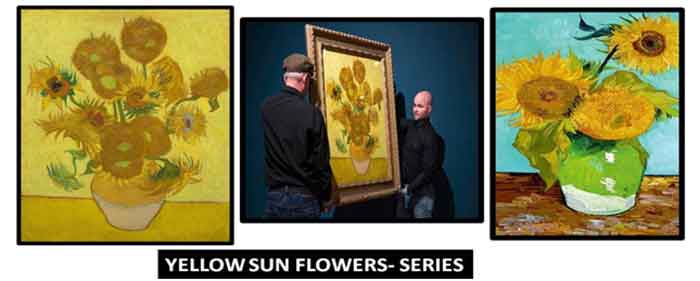
But this is where an unfortunate story was born. Van Gogh was polite, listening, respectful, and as against him was Paul Gauguin, overly stubborn, self-centered, and disrespectful of people’s feelings. Van Gogh was overjoyed when Paul Gauguin arrived. A few days later, Van Gogh presented his idea of an ‘Artist Colony’ to Paul Gauguin. Plans were made to involve other painters in the colony. Unfortunately, Paul Gauguin categorically refused to accept the idea and intimated his decision to leave. It was a huge, unbearable blow to Van Gogh. Van Gogh was so overwhelmed with grief that he collapsed in his heart, and Van Gogh submerged in to Depression and was shocked. He had a heated argument with Paul Gauguin and Paul packed up and left. Van Gogh’s dreams of an ‘artist colony’ were shattered In a fit of sadness, he cut off his left ear. He could not stand the end of his friendship.
The last 2 weeks of Van Gogh’s death and his inspiring legacy
He was very upset and frustrated. He was upset at the thought that his brother ‘Theo’ had put all his life into it. The roots of the trees, the crazy crooked branches that come up, these pictures show the storms that come in Human mind and life.

It was at this point in 1890 that he drew a ‘picture of nature’ of a wheat field and crows flying over it, as if he was fascinated by the last moments of his life!

Vincent is believed to have committed suicide by shooting himself in the chest on July 27, 1890, while on a farm in Auvers-Sur- Oise.. He died two days later, on July 29, 1890, while his brother Theo was sitting by his bedside.
Several reasons are given for his suicide, including the financial disaster that befell Theo. In May 1890, he was discharged from Asylum and moved to the quiet village of Overs-sur, north of Paris. But on the way back he went to his house to meet Theo-Johanna and their son. He felt uncertain about the future and sad that he had failed as an artist. But whatever the reason, a deterioration in his mental health led to his suicide. He was only 37 at the time!
Although his career as a painter came to an end after his death, his legacy has been preserved as one of the great painters of the future who inspired the world. His fame grew after his death. He is counted among the greatest painters in the world. He is considered one of the founders of modern art.

In the unanimous opinion of Psychiatrists and Psychoanalysts the haunting images in his Unconscious, of his dead brother and estrangement from mother’s love, made him to traverse through innumerable repressive hurdles through various stages marked with Anxiety, seizures, hallucinations, nightmares, bipolar disorder. Despite these psychic vulnerabilities he could create wonders through various forms of his paintings and Art work. Hence it is important to see how remarkable was his struggle for Self Articulation, phenomenal speed at which he carried forward in innumerable Forms. Van Gogh, while battling a life-threatening mental illness, created a great art gallery by overcoming mental Repression in just ten years. He can only be compared to Faydar Mikhalovich Dostoevsky, a Russian writer who has mastered the field of literature.
ORIGINAL ARTICLE IN MARATHI ON –‘www. Marathisrusti.com’. ‘ Articles / Pratibha-vinscent- van- Gogh-chi Part 1 & 2. Translation, into English by Anil Gokhale
Vasanti Gokhale is a Marathi writer.



